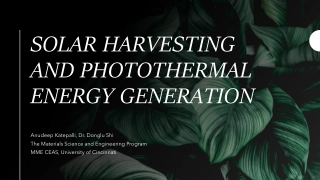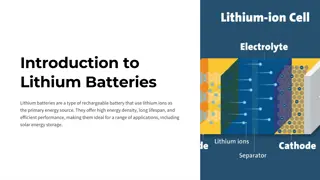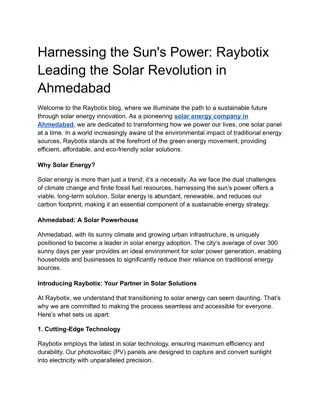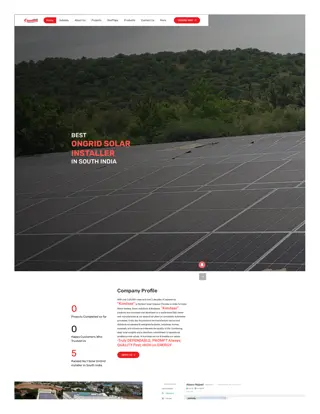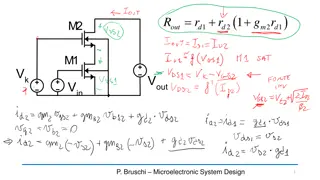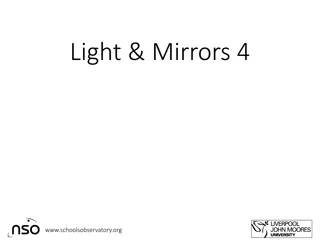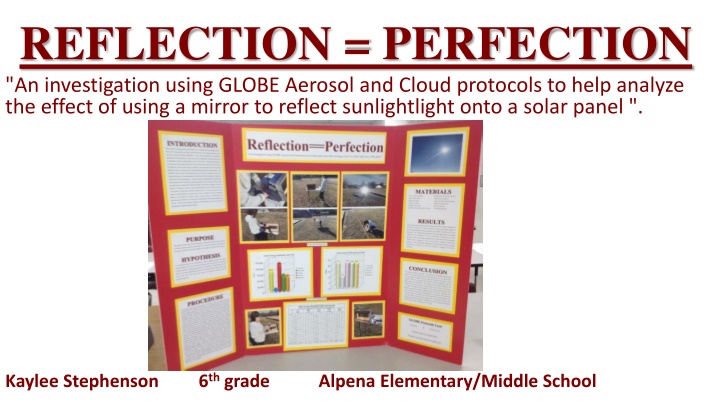
Investigating Solar Panel Efficiency Using Mirrors
This project explores the impact of reflecting sunlight onto a solar panel using mirrors at varying distances. The researcher analyzes the electricity generated and atmospheric conditions to understand the potential benefits in harnessing solar energy efficiently.
Download Presentation

Please find below an Image/Link to download the presentation.
The content on the website is provided AS IS for your information and personal use only. It may not be sold, licensed, or shared on other websites without obtaining consent from the author. If you encounter any issues during the download, it is possible that the publisher has removed the file from their server.
You are allowed to download the files provided on this website for personal or commercial use, subject to the condition that they are used lawfully. All files are the property of their respective owners.
The content on the website is provided AS IS for your information and personal use only. It may not be sold, licensed, or shared on other websites without obtaining consent from the author.
E N D
Presentation Transcript
REFLECTION = PERFECTION "An investigation using GLOBE Aerosol and Cloud protocols to help analyze the effect of using a mirror to reflect sunlightlight onto a solar panel ". Kaylee Stephenson 6thgrade Alpena Elementary/Middle School
INTRODUCTION Solar panels are being used more and more in residential housing applications. The use of solar panels can help cut electrical costs, save natural resources, and provide a clean electricity alternative. One of the drawbacks to residential application of solar panels in rural areas can be finding an area where they can be installed in direct sunlight that is close to the house. If the solar panels are too far away, then longer electrical cable has to be used, which can cut down on the efficiency of the solar energy collected. In some areas of the world, high definition mirrors can be used to concentrate the Sun's rays on solar panels. The GLOBE Aerosol and Cloud protocols can be used to measure the Aerosol Optical Thickness in the atmosphere and document the atmospheric conditions at the time of the investigation. In order to better understand this investigation, the researcher had to learn some new terminology such as Lumen and Lux which are both used to measure the amount of light. According to a paper written by David L. Crawford; "Lumen is the unit of the light current which indicates the total amount of light given off by the light source. Lux is used to measure the amount of light output in a given area. Direct sunlight can have a luminous efficacy of around 93 lumens which would provide an illuminance of approximately 98,000 Lux". The type of solar panel used in the investigation is a 9cm x 30cm Solar Battery Charger and Maintainer that can be used on automobiles, and recreational vehicles. Kaylee Stephenson
PURPOSE This project was the result of an investigation to analyze the effect of using a mirror to reflect sunlight toward a solar panel in a location where the solar panel is facing away from the Sun from distances of 5 meters, 10 meters, and 15 meters. HYPOTHESIS It was predicted that it would be possible to reflect sunlight toward a solar panel which is facing away from the sun and still generate at least 80% of the amount of electricity that could be generated is the solar panel is facing directly toward the sun. It is also predicted that as the mirror is placed father away from the solar panel, (5m, 10m, and 15m,) the amount of electricity produced will be proportionally less Kaylee Stephenson
PROCEDURE On a bright Sunny day, the researcher set up the 9cm x 30cm solar panel on a table where it was facing toward the sun. The date and time was be recorded. The GLOBE protocols for Aerosols and Clouds were followed to analyze the Aerosol Optical Thickness (AOT), and to record the current atmospheric conditions. The Aerosol and Cloud Observation data were submitted to the GLOBE database. Then, a voltage meter was connected to the solar panel in order to measure the amount of electricity produced. A digital Lux light meter was used to measure the amount of light given off by the sun. Ten Lux readings were recorded. The solar panel was adjusted so that it is facing directly toward the sun. Ten different voltage output readings from the solar panel were recorded. Next, the solar panel was turned around so that it was facing away from the direct sunlight. The light meter was used to measure the Lux readings that the solar panel was receiving. The volt meter was used to measure the voltage output from the solar panel while it was in the indirect sunlight position. Next, the researcher used a 15-meter measuring tape to measure and mark off distances of 5m, 10m, and 15, from the solar panel. Flags were placed in the ground to mark the distances. After that, a 20cm x 50cm mirror was used to reflect sunlight directly onto the solar panel from distances of 5 meters, 10 meters, and 15 meters. For each distance, ten readings were recorded for Lux readings of light and the voltage that the solar panel produced. Kaylee Stephenson
MATERIALS 9cm x 30cm Solar Panel 20cm x 50cm Mirror Digital Lux meter Digital Volt Meter GLOBE Cloud Guide GLOBE Protocols Aerosols & Clouds Digital Calitoo meter for Aerosols iPad for Documentation paper-box lid to hold Solar Panel Portable Fold-up Table Pink Survey Flags 15m Measuring Tape Kaylee Stephenson
Reflecting Sunlight onto Solar Panel Kaylee Stephenson
RESULTS The average light readings for the solar panel placed in direct sunlight was 82,970Lux, resulting in 21.46volts produced. The average light readings for the solar panel placed in indirect sunlight was 5,750Lux, resulting in 9.52volts produced. The average light readings for the solar panel with the sunlight reflected from a distance of 5m was 106,790Lux, resulting in 21.7volts produced. The average light readings for the solar panel with the sunlight reflected from a distance of 10m was 58,710Lux, resulting in 20.99volts produced. The average light readings for the solar panel with the sunlight reflected from a distance of 15m was 56,280Lux, resulting in 20.77volts produced. Kaylee Stephenson
Solar Energy Reflected Light Test Results (Light measured in Lux = Lumens per square meter, Electricity measured in Volts DC) Direct Sunlight Control Indirect Sunlight Control Reflected Sunlight 5 meters Reflected Sunlight 10 meters Reflected Sunlight 15 meters Test # Lux Volts Lux Volts Lux Volts Lux Volts Lux Volts 1 82,100 22.0 730 9.7 108,900 21.7 59,600 20.4 56,400 20.9 2 82,700 21.5 650 9.6 105,400 21.8 53,700 20.8 58,400 20.6 3 83,000 21.4 620 9.5 103,000 21.7 60,400 21.0 52,800 20.4 4 83,000 21.5 420 8.9 110,700 21.8 63,200 21.1 59,600 21.0 5 83,100 21.4 550 9.7 110,300 21.6 53,600 21.2 57,100 20.8 6 83,000 21.4 790 9.6 108,700 21.7 57,200 21.3 57,800 20.9 7 83,100 21.4 500 9.5 107,900 21.6 61,200 20.8 58,300 20.6 8 83,200 21.3 460 9.5 105,300 21.7 63,500 21.2 54,600 21.0 9 83,300 21.4 550 9.6 103,200 21.7 57,800 20.9 53,700 20.8 10 83,200 21.3 500 9.6 104,500 21.7 56,900 21.2 54,100 20.7 Total 829,700 214.6 5,750 95.2 1,067,900 217 587,100 209.9 562,800 207.7 Mean 82,970 21.46v 575 9.52v 106,790 21.7v 58,710 20.99v 56,280 20.77v Kaylee Stephenson
CONCLUSION The results were rather interesting. The hypothesis was partially supported by the data. The voltage output from the light reflected on the solar panel from 5m was actually 1% higher than the solar panel readings recorded in direct sunlight. However according to the statistics t-Test, the difference was not high enough to be significant. The readings from the light reflected at 10 meters showed a 2% decrease in voltage and the 15m showed a 3% decrease in voltage. According to the statistics t-Test, both the 10m and the 15m distances resulted in a significant difference, but it was close. When the solar panel was placed in the indirect sunlight position, it resulted in a 56% decrease in voltage output. According to the overall results from the investigation, the researcher believes that reflecting sunlight onto a solar panel could provide enough light energy to generate a significant amount of electricity if placing the solar panel in direct sunlight is not an option. Kaylee Stephenson


